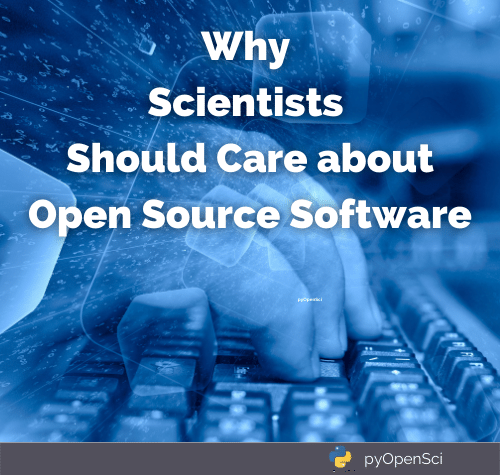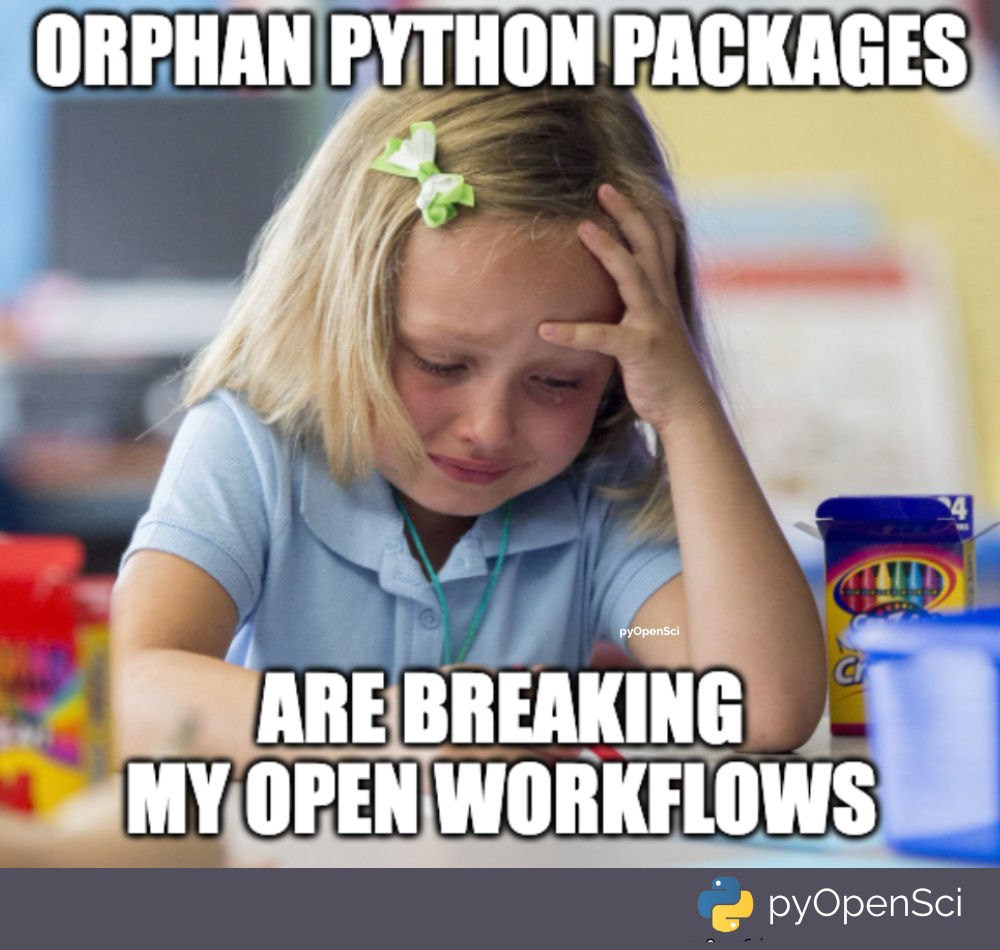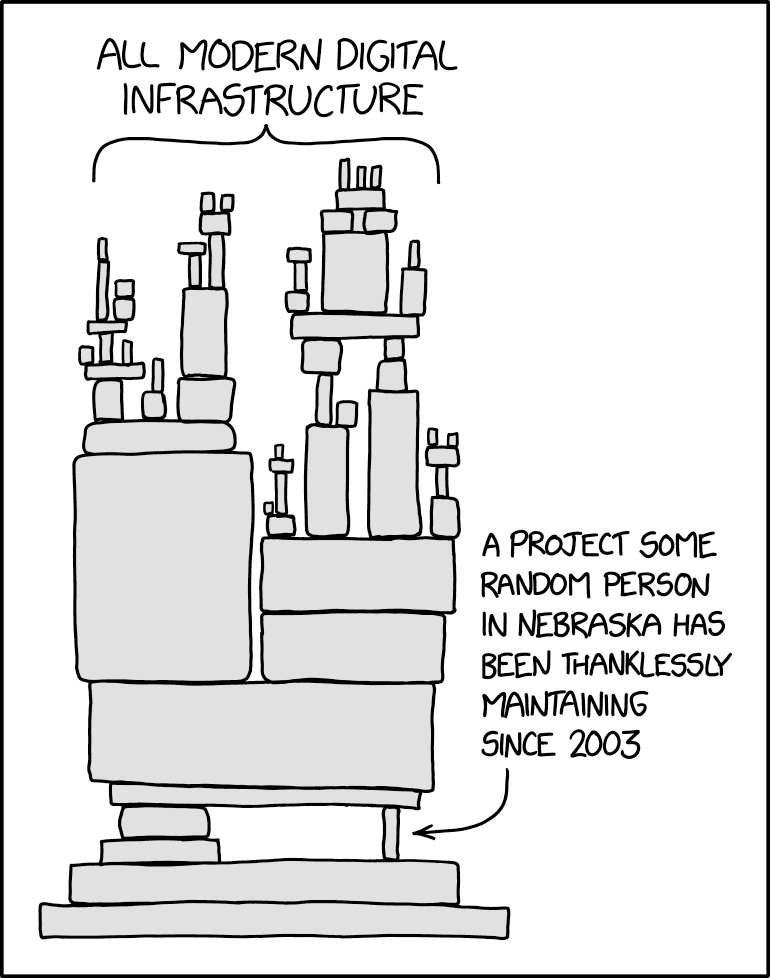Part 1/3: Blog series on package health
This blog post is part 1 of a 3 part series on open source package health. The series was inspired by a conversation held on twitter. This blog post is not a comprehensive perspective on what pyOpenSci plans to track as an organization. Rather it’s a summary of thoughts collect during the conversation on twitter that we can use to inform our final metrics.
Why Python open source package health should matter to you as a scientist
If you are a scientist, the health of a scientific python package may not be something that you care about. What might seem more important is doing your science, and processing your data to get to that coveted scientific inquiry and exploration stage.
In actuality, package health is incredibly important to science, especially open, data-intensive science. It should be important to you too!
Why? Let me provide a few reasons below:
1. Free and open source tools (FOSS) make your code simpler.
Free and open source tools provide commonly needed functionality wrapped up in simple tested functions and objects that you don’t need to recreate yourself.
If you are creating open workflows to process your data, you are likely using free-to-download (and use) tools - software. These tools make it easier for you to access, open, process and visualize your data. These free and open tools allow allow you to write less (complicated) code to process your data. Code that someone else (a package maintainer) maintains (often in their spare time but we’ll get to that in another blog post!).
2. Open source software provides centralized maintenance of commonly used workflows
Imagine 1,000 scientists accessing climate data. They all need to download the data and plot it. However they made download different types of climate data, different models, different variables. The base code that all 1,000 scientists write to download and open the data is the same. Similarly the base code for plotting is also the same.
Isn’t it better that one person writes great code and updates it as things like the download API change? Or they update plotting functionality?
-
This central maintenance avoids you and many other people needing to write code that does the same thing. It makes it easier for you to process your climate data and get to the science. Your code is simpler.
-
This centralization of tools that perform tasks that many people need to do avoids the problem of 1,000 people trying to create the same workflow and creating different and potentially problematic code.
-
This avoids everyone reinventing the scientific wheel.
3. Free and open source software reduces the barrier of needing a paid license to build upon your work.
Free and open source software removes the barrier a paid license to run your code. This makes your work more accessible.
There is a lot more to say about the value of open source here but i’ll leave that to another blog post.

Creating and maintaining open source software is hard work
Creating these open source tools to work with data is not a trivial task. Often the people (who may be developers or scientists) who develop the tools:
- Aren’t paid to do the work
- Burn out from all of the effort associated with supporting the tools
- Aren’t acknowledged for their effort
- Have to deal with users who are frustrated by bugs, but aren’t able to communicate that frustration kindly or effectively to help the maintainer get it fixed while also acknowledging their effort (which again is often volunteer)
Maintainers also get new jobs, and need to step away from maintaining that tool.
All of the above causes a challenge where once-maintained tools are now left unmaintained and vulnerable to new bugs as other packages that tool depends on are updated, or as the Python language itself is updated.
Package usability is also important but not always considered by maintainers
Not all developers focus on usability when designing a new tool. Some do. Maintainers often start, as expected, with trying to get a job done. Documenting a package well enough so that a beginner can get started with using it, is not always an immediate goal.
Yet usability is critical to developing a user base. To making a tool accessible to more people which could in turn help grow community around it that supports that tool.
This can be frustrating for scientists who are trying to find the right tool to use to support their analysis. And as such another area that we definitely want to consider when building pyOpenSci.
Maintainers do a lot of hard work and rarely get credit for it
Before I say anything else here:
Please - cite software in your work if you use it! And also if you need to report a bug, please do so in a kind and thoughtful way!
Maintainers work hard on their packages. One package may be the foundation for data processing and analysis across hundreds to thousands (or more) scientific papers. But unlike scientific papers, work on the package continues long after a paper is published. A package is a living thing that needs continual work and love.
So, what happens to that package that you are using in your workflow, when the developer gets a new job or finds they no longer have the time to maintain it? What happens when you need to update your workflow to support a paper review OR when you want to build upon it for another analysis if that tool no longer is maintained?

This, my friend, is why you should care about, and support, open source software!
pyOpenSci is designed to create diverse community for and to support the open source Python tools that you as a scientist are using in your workflows.
The issues discussed above around maintenance, usability and quality of software, are the types of issues that pyOpenSci will address.

But we (pyOpenSci) need to track package use, and maintenance, collect data and quantify outcomes to determine if we are making the impact that we want to. To determine if we are truly helping you, as a scientist in selecting the tool that will help you in your workflow and also be maintained over time and documented enough that you can get started using it quickly.
We also want to ensure that we are supporting maintainers as well. To help them with the hard job of showing up each day to maintain a package that maybe hundreds to thousands of scientists are using.
pyOpenSci needs to collect data around metrics to track all of these issues
pyOpenSci needs to do more than just open peer review of scientific Python packages. We need to collect data to better understand the issues and how we impact those issues over time.
A few package-related goals of pyOpenSci include:
- Ensure that package quality is better after the review than before
- Inspire maintainers to develop more robust package infrastructure including testing
- Improve the usability of packages through documentation and vignettes (short tutorials showing users how to get started with the package)
- Ensure that packages are maintained over time; If they aren’t maintained, ensure that they are archived or sunsetted in a way that users know they are no longer maintained. (no more dark orphan repositories!)
To make sure we reach our goals, we have to collect metrics on packages submitted to our open peer review process to track quality and health over time. And hopefully, through our review process and support of maintainers, we will help to improve the overall quality of packages being created to support scientific workflows.
We want to help the community.
How pyOpenSci hopes to improve the usability and quality of smaller open source software packages that support science
These, my friend are lofty goals. But our mission is to help scientists build better software. And to ensure that the community understands the maintenance level of that software before they adopt using it.
We also want scientists to understand how hard maintainers work to create the tools that they use. And to cite that work if they use the tools in the same way they might cite a peer reviewed article. But that is another blog to be written.
So how do we track open source tool health (for science)?
Peer review is actually the second step in our process.
We won’t begin to review a package without bare minimum checks. We hope that these bare minimal checks help maintainers as they try to decide what is good enough infrastructure for their package.
We hope that these checks will also help new maintainers that are creating new packages even if they never submit their package to us for peer review.
Goals for package metrics
These metrics will help us quantify several of our goals:
We hope that:
- Peer review improves Python package structure and usability.
- Peer review in some way supports maintenance and/or responsible archiving when a package comes to life-end.
- Over time, the package is improved and maintained with possible contributions for those other than the maintainer.
We need metrics to understand things like
- Community adoption of the package (are scientists using it?)
- Maintenance level of the package (are maintainers still working on it and fixing bugs?)
- Infrastructure (are tests setup to help identify if contributions break things? )
- Usability (is the package documented in a way that helps users quickly get started)
A discussion about package health on twitter
A few weeks ago, I posted on twitter to see what the community thought about “what constitutes package health”.
controversial topic: How do we measure the "health" of a #science #python package? GitHub stars? downloads, date of latest commit? # of commits a month / quarter? Spread of commits? Thoughts? #opensource #OpenScience @pyOpenSci
— Leah Wasser 🦉 (@LeahAWasser) October 5, 2022
The twitter convo made me realize that there are many different perspectives that we can consider when addressing this question.
More specifically, pyOpenSci is interested in the health of packages that support science. So we may need to build upon already existing efforts that determine metrics and customize them to our needs.
Continue reading the blog series on package health
This blog post is part 1 of a 3-part series.
In the final post of this three part blog series, I’ll recap a conversation held on twitter around package health metrics. This conversation will be used to define the types of metrics that we will collect as an organization.
Feedback? Leave it below
If you have any thoughts on pyOpenSci metrics and goals or questions, please leave them in the comments below!
Connect with us!
There are many ways to get involved if you’re interested!
- If you read through our lessons and want to suggest changes, open an issue in our lessons repository here
- Volunteer to be a reviewer for pyOpenSci’s software review process
- Submit a Python package to pyOpenSci for peer review
- Donate to pyOpenSci to support scholarships for future training events and the development of new learning content.
- Check out our volunteer page for other ways to get involved.
You can also:
- Keep an eye on our events page for upcoming training events.
Follow us on social platforms:
If you are on LinkedIn, check out and subscribe to our newsletter.
You can also:
- Check out our Python Package Guide for comprehensive packaging guidance
- Keep an eye on our events page for upcoming training events

Leave a comment